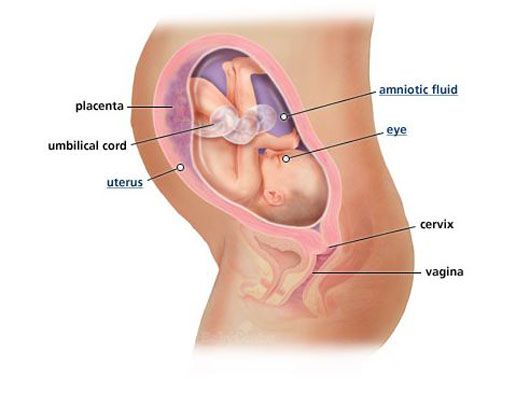Amniotic Fluid - what is and levels

What is Amniotic Fluid
Amniotic Fluid - The liquid that surrounds the developing FETUS within the amniotic sac, a membranous structure that forms inside the UTERUS in PREGNANCY. The amnion, the inner membrane of the amniotic sac, begins producing amniotic fluid at about two weeks of gestation. The amniotic fluid, which is mostly water, cushions the fetus against changes in temperature as well as jarring and bumps from outside the womb. The composition of amniotic fluid changes somewhat over the duration of pregnancy though typically includes, in addition to water, electrolytes, lipids, proteins, metabolic byproducts, and cells that the fetus sheds. These cells provide the DNA that AMNIOCENTESIS uses to assess the health of the fetus.
Amniotic fluid is essential not only to protect the fetus but also for proper fetal development. In the second trimester the fetus swallows and “breathes” to take amniotic fluid into its STOMACH and LUNGS, which is necessary for development of the structures and functions of the pulmonary and gastrointestinal systems. The fetus also begins contributing URINE to the composition of the amniotic fluid. By the third trimester the amniotic fluid replenishes itself about every three hours and reaches a volume of approximately 500 milliliters. The amniotic sac ruptures when CHILDBIRTH is imminent, sending a flood of amniotic fluid from the woman’s VAGINA. This process is the “breaking water” that often heralds the onset of pregnancy’s final stages, labor and delivery.
Amniotic Fluid Levels
A lower than normal volume of amniotic fluid is oligohydramnios, which may constrict the movement of the fetus to an extent that causes abnormal musculoskeletal development, intrauterine growth retardation, and other problems. A greater than normal volume of amniotic fluid is polyhydramnios, which may indicate NEURAL TUBE DEFECTS or BIRTH DEFECTS of the KIDNEYS or gastrointestinal structures. Polyhydramnios is sometimes present when the mother has diabetes. It presents increased risk for UMBILICAL CORD problems such as umbilical cord prolapse (the umbilical cord enters the vagina before the fetus’s head as birth begins, a potentially life-threatening scenario for the fetus), as well as large for gestational age or macrosomia (birth weight significantly higher than normal).
For further discussion of amniotic fluid within the context of the structures and functions of reproduction and sexuality, please see the overview section “The Reproductive System.”
See also CESAREAN SECTION.
Open discussion on the topic Amniotic Fluid - what is and levels
Similar interests
- Nuovi Casino
- Casinos Not On Gamstop
- UK Casinos Not On Gamstop
- Casinos Not On Gamstop
- UK Casinos Not On Gamstop
- Casino Non Aams Italia
- Slot Sites Not On Gamstop
- Meilleur Casino En Ligne
- Non Gamstop Casino Sites UK
- Meilleur Casino En Ligne
- Casino En Ligne France
- Best Non Gamstop Casinos
- Casinos Not On Gamstop
- UK Casino Not On Gamstop
- Casinos Not Signed Up To Gamstop
- Best Slot Sites UK
- Non Gamstop Casino Sites UK
- Online Casinos Nederland
- Online Casinos Nederland
- Casinos Not On Gamstop
- Best New Uk Casinos Not On Gamstop
- Casino Non Aams
- Non Gamstop Casinos UK
- Migliori Siti Casino Non Aams
- Bitcoin Casinos
- Sites De Paris Sportifs Belgique
- Bookmaker Non Aams
- Casino En Ligne